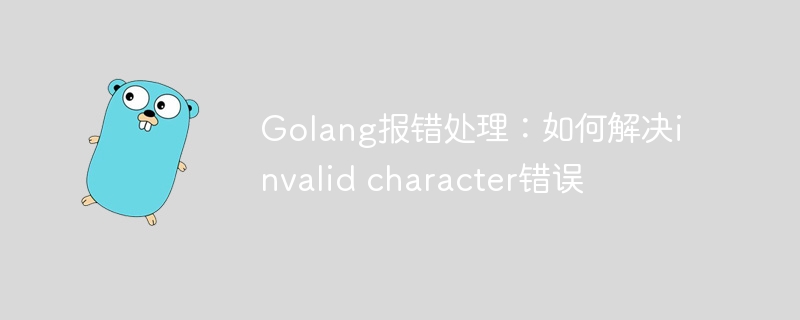Home >Backend Development >Golang >Golang error handling: how to solve invalid character error
Golang error handling: how to solve invalid character error
- WBOYWBOYWBOYWBOYWBOYWBOYWBOYWBOYWBOYWBOYWBOYWBOYWBOriginal
- 2023-11-25 08:51:362863browse

Golang error handling: How to solve the invalid character error
Introduction:
Go language (Golang) is a modern and efficient programming language, but in development During the process, we may encounter various errors. One of the common errors is the "invalid character" error. This article will explain what the "invalid character" error is, why it occurs, and how to fix it.
What is "invalid character" error?
"invalid character" errors usually appear in Go source code files. It indicates that there is an illegal character in the code, which cannot be correctly parsed by the compiler. This kind of error may cause the program to fail to compile and run normally.
Why does the "invalid character" error occur?
There are multiple possible reasons for the "invalid character" error. The following are some common reasons:
- Non-ASCII characters: The standard ASCII character range of the Go language is 0-127. Characters outside this range may trigger "invalid character" errors. For example, sometimes when we copy and paste code, we may accidentally insert a non-ASCII character, causing an error.
- Character encoding problem: If your code file uses a non-UTF-8 character encoding, it may also cause "invalid character" errors. The Go language requires that source code files must be encoded in UTF-8.
- Special characters in comments: Sometimes, using some special characters in comments, such as special Unicode characters or illegal escape sequences, will also cause "invalid character" errors.
Methods to solve "invalid character" errors:
The following are several common methods to solve "invalid character" errors:
- Check the code file : First, make sure that the code file itself does not have any illegal characters or encoding issues. You can use a text editor or IDE to view the character encoding of the code file and make sure to use UTF-8 encoding. You can also copy the code file into a new text file and try to compile the new file to verify if the error still exists.
- Check the copied and pasted code: If you copy and paste a piece of code and trigger the "invalid character" error, you can check the copied and pasted code to confirm whether there are non-ASCII characters in it. You can try manually re-typing the code to ensure that no illegal characters appear.
- Check comments: Sometimes, "invalid character" errors can be caused by special characters in comments. Check for special characters used in comments, especially Unicode characters or escape sequences. Try removing or replacing these special characters and recompile the code.
- Use appropriate escape sequences: If you need to use special characters in strings or character constants, make sure to use appropriate escape sequences. For example, use `
to represent a newline character and"` to represent a double quote. This will avoid "invalid character" errors. - Check the library file: If you are using a Library file, and encountered an "invalid character" error, you can check whether the library file is encoded using UTF-8 and does not contain non-ASCII characters.
Summary:
"invalid character " error is one of the common errors in the Go language. It indicates that there are illegal characters in the code and cannot be correctly parsed by the compiler. To solve this error, you can check the encoding of the code file, the copied and pasted code, and the Special characters and appropriate escape sequences. Make sure that both code and library files use UTF-8 encoding and do not contain any non-ASCII characters to minimize the occurrence of "invalid character" errors.
The above is the detailed content of Golang error handling: how to solve invalid character error. For more information, please follow other related articles on the PHP Chinese website!

